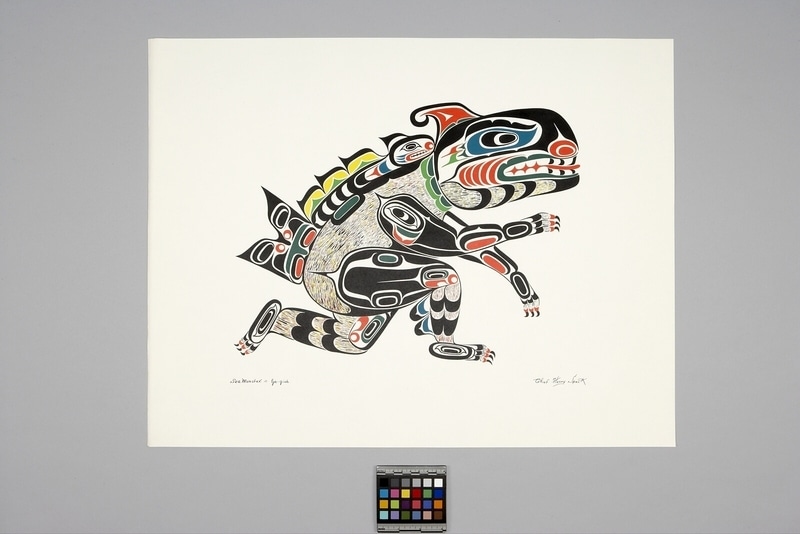Sea Monster, Ya-Gish Item Number: Nb3.1341 from the MOA: University of British Columbia

Description
Configurative design of a sea monster in Kwakwaka'wakw style. The figure is crouching on one knee and the other knee is at a right angle. The arms are out-stretched. The head is a large black outlined ovoid with blue-green eye sockets, teeth, a large red nostril and tongue with red, yellow, and black dash lines all over body. The arms are made of three ovoids of different sizes and are clawed as are the feet. It has fins on its back in u forms and multi-coloured ovoids. A creature is on its back with an open red mouth and ovoid eyes on the feet, knees, and shoulders. Black inscription below image. The print is on vertically rectangular, off-white paper.
History Of Use
Northwest Coast print making is a relatively new art form, which began in the late 1940's, but did not develop until the late 1960's. The establishment of the Northwest Coast Indian Artists Guild, in 1977, aided the implementation of standards in limited addition runs and various aspects of quality control. Silk-screen prints have been used to portray traditional and contemporary themes, as well as, to make personal statements. Kwakwaka'wakw artists have, in general, preferred to work with traditional crest designs and mythical themes. More colours are used by Kwakwaka'wakw artists than are used by northern Northwest Coast artists, and the images are composed of many small elements combining into relatively realistic forms.
Cultural Context
contemporary art
Iconographic Meaning
Sea monsters take different forms and have different names, frequently they are whale-wolf combinations and thus have coiled tails, clawed feet, flippers and dorsal fins.
Narrative
Nb3.1335 to Nb3.1343 were given to Audrey Hawthorn in 1973. This collection of Henry Speck prints is from an unnumbered collection probably printed in the 1960's.
Item History
- Made by Chief Henry Speck (Maker) in British Columbia, Canada during 1962
- Collected during 1973
- Owned by Audrey Hawthorn before June 21, 1976
- Received from Audrey Hawthorn (Donor) on June 21, 1976
What
- Name
- Sea Monster, Ya-Gish
- Identification Number
- Nb3.1341
- Type of Item
- Manufacturing Technique
- silkscreened
- Overall
- height 48.2 cm, width 62.5 cm, depth 0.1 cm
Who
- Culture
- Kwakwaka'wakw
- Creator
- Chief Henry Speck (Maker)
- Previous Owner
- Audrey Hawthorn
- Received from
- Audrey Hawthorn (Donor)
Where
- Holding Institution
- MOA: University of British Columbia
- Made in
- British Columbia, Canada
When
- Creation Date
- during 1962
- Collection Date
- during 1973
- Ownership Date
- before June 21, 1976
- Acquisition Date
- on June 21, 1976
Other
- Item Classes
- works on paper
- Condition
- fair
- Accession Number
- 0309/0013